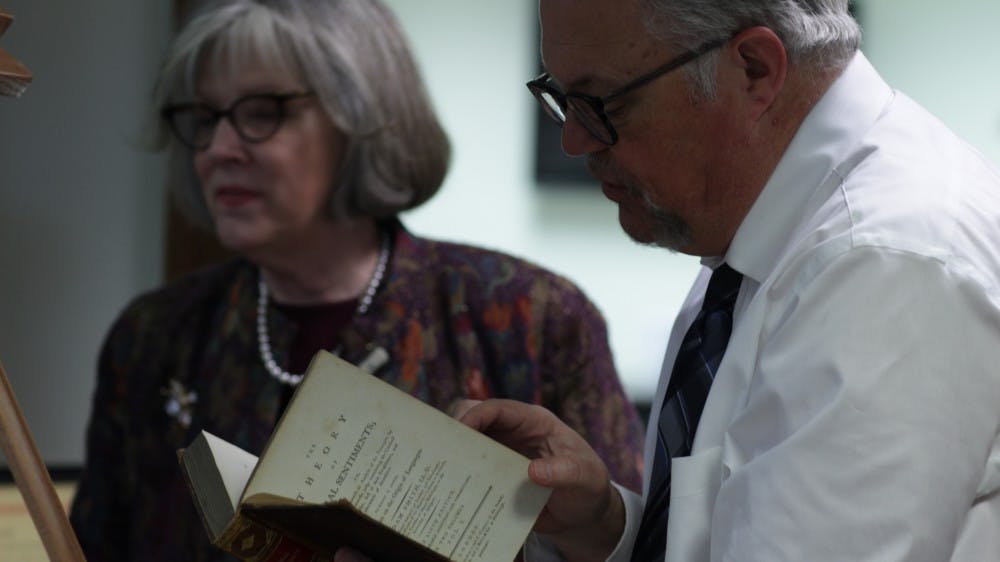To view these materials, contact Cecil Bohanon at 765-285-5363 or by email at cbohanon@bsu.edu.
Specific times must be set for making trips to the E.B. Ball Center through Diane Waters and/or Kathryn Kennison at 765-285-8975.
Preferred times for visits are between 9-11 a.m. Tuesdays and 2-4 p.m. Thursdays.
Thirty-three books are sitting under glass at the E. B. and Bertha C. Ball Center — but these aren't your regular paperbacks.
Some are by philosophers, poets or novelists. Notable names — including the likes of Aristotle, Galileo Galilei, Alexander Hamilton, John Locke and Mary Wollstonecraft — are still legible on the spines. Many are first editions, and most are difficult to come by. A Vulgate Bible is the oldest in the assortment, dating back more than seven centuries.
The rare and ancient books are on loan from The Remnant Trust, a public educational foundation, which makes the collection of early works accessible to the public. Through various grants and donations, economics professor Cecil Bohanon helped bring the public display to Ball State in hopes of “helping [us] understand the present by looking at the past.”
Despite their age, he said, the books aren’t meant to be under lock and key. Instead, visitors are encouraged to get up close and spend time examining the texts for themselves.
“There’s something magical, I think, about touching something that was done at that earlier age,” Bohanon said. “These are not things that no one should touch. It’s part of our heritage, and so you’ll want to be able to feel and look at and read it.”
Bohanon, who has a knack for working with students on immersive learning projects, is integrating the books into his ongoing special project economics class, Econ in Motion.
This semester, students in the class are studying the Scottish Enlightenment and will create a film script about the intellectual and scientific accomplishments happening in Scotland during that time. A fall iteration of the course will put the script into production.
Students have already started reading some of the texts, and by using the books on loan, the experience has been different from most other reading assignments.
“It was surreal to see and read the actual books that caused so much controversy at the time that they were published,” Chase Curry, a senior economics major in Bohanon’s class, said. “There are just so many works in the room that we’ve read … and it was just incredible to see them all, like the Magna Carta, The Twelve Pamphlets including The Law, the Articles of Confederation … that was very surreal.”
As a part of the project, the Ball State students will also share what they’ve learned with classes at local high schools.
Junior economics major Noah Underhill said that’s a part of the semester he’s looking forward to, especially since he was one of those high school students not so long ago.
“When [Bohanon] came and his students presented their videos to my class when I was in high school, it really sort of started my interest in econ and growing it,” Underhill said. “I’m hoping we can do that with some of the other students we help lecture and get them interested, too.”
The books are anticipated to be on display until May. Professors and students at other universities around the state are expected to make visits in the coming months, and Kathryn Kennison, director of the E. B. and Bertha C. Ball Center, is hoping others will schedule times to visit the assortment of books, too.
“It makes the best of sense that [the collection] is here, because our reason for existence is for community enrichment,” Kennison said. “I think it would be hard to find anything that would be more enriching for this community — or for any community — than these books that contain the ideas that formed Western civilization.”
Senior economics major Colin Steitz agreed, adding that he wants more of his peers — regardless of what they’re studying — to take a look at the rare books for themselves.
“I think it’s always incredible to see a book that has survived for hundreds and hundreds of years, especially considering what that book went through from original printing to now,” Steitz said. “I just encourage that anyone who’s interested set up an appointment and come down and see [the books]. That’s the best way to truly engage with these, outside of just reading the texts, and to actually see the works and see their importance and see that they have survived this long.”
Contact Casey Smith with comments at casmith11@bsu.edu.





